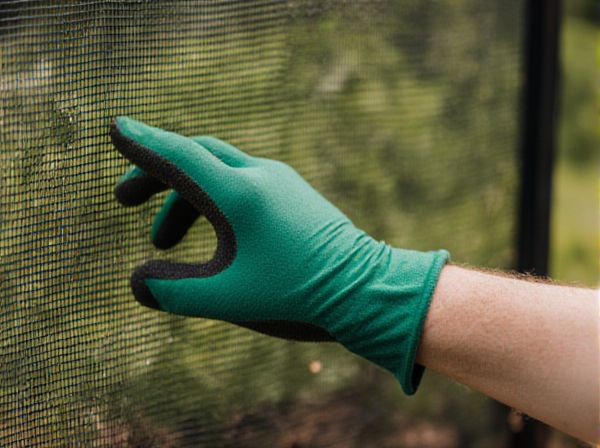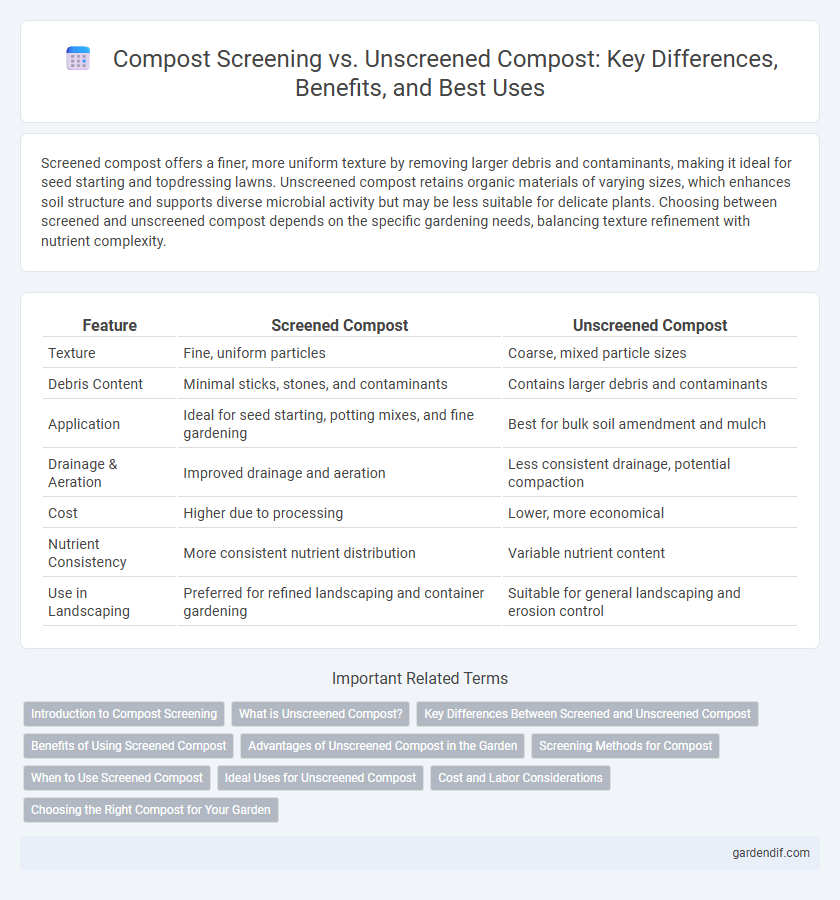
Compost Screening vs Unscreened Compost Illustration
Screened compost offers a finer, more uniform texture by removing larger debris and contaminants, making it ideal for seed starting and topdressing lawns. Unscreened compost retains organic materials of varying sizes, which enhances soil structure and supports diverse microbial activity but may be less suitable for delicate plants. Choosing between screened and unscreened compost depends on the specific gardening needs, balancing texture refinement with nutrient complexity.
Table of Comparison
| Feature | Screened Compost | Unscreened Compost |
|---|---|---|
| Texture | Fine, uniform particles | Coarse, mixed particle sizes |
| Debris Content | Minimal sticks, stones, and contaminants | Contains larger debris and contaminants |
| Application | Ideal for seed starting, potting mixes, and fine gardening | Best for bulk soil amendment and mulch |
| Drainage & Aeration | Improved drainage and aeration | Less consistent drainage, potential compaction |
| Cost | Higher due to processing | Lower, more economical |
| Nutrient Consistency | More consistent nutrient distribution | Variable nutrient content |
| Use in Landscaping | Preferred for refined landscaping and container gardening | Suitable for general landscaping and erosion control |
Introduction to Compost Screening
Compost screening separates fine, nutrient-rich particles from larger debris, enhancing soil texture and promoting better plant growth. Screened compost improves aeration and nutrient availability by removing sticks, stones, and uncomposted materials. This process ensures a uniform, high-quality product ideal for landscaping, agriculture, and gardening applications.
What is Unscreened Compost?
Unscreened compost contains a mix of fully decomposed organic material alongside larger, coarse particles such as wood chips, twigs, and other debris that have not been separated or finely processed. This type of compost retains more texture, which can improve soil aeration and drainage but may require longer application time for nutrients to fully integrate into the soil. Compared to screened compost, unscreened compost is often less uniform but can be more cost-effective for large-scale landscaping or soil amendment projects where fine particles are less critical.
Key Differences Between Screened and Unscreened Compost
Screened compost undergoes a sifting process to remove large debris, stones, and non-compostable materials, resulting in a finer, more uniform texture ideal for seed starting and delicate plants. Unscreened compost retains larger particles and organic matter, which enhances soil structure and moisture retention but may contain more weed seeds and contaminants. Choosing between screened and unscreened compost depends on the specific gardening application, with screened compost preferred for precision tasks and unscreened compost beneficial for general soil improvement.
Benefits of Using Screened Compost
Screened compost provides a fine, uniform texture that improves soil structure and promotes better root growth compared to unscreened compost. By removing large debris, rocks, and uncomposted materials, screened compost enhances nutrient availability and reduces the risk of introducing weed seeds or pathogens into the soil. This refined compost accelerates plant establishment, improves water retention, and supports healthier, more vigorous plant development.
Advantages of Unscreened Compost in the Garden
Unscreened compost retains larger organic particles and natural debris, promoting improved soil structure and enhanced microbial activity. The coarse texture increases aeration and water retention, benefiting root development in garden plants. Nutrient diversity in unscreened compost supports a more balanced and sustainable growing environment compared to screened compost.
Screening Methods for Compost
Screening methods for compost involve passing the material through mesh screens to separate fine, usable compost from larger debris and contaminants. Common techniques include trommel screens, vibrating screens, and rotary drum screens, each optimizing particle size uniformity and enhancing compost quality. Proper screening improves nutrient availability and accelerates soil integration compared to unscreened compost, which may contain larger, undecomposed materials and impurities.
When to Use Screened Compost
Screened compost is ideal for applications requiring fine, uniform material such as seed starting, potting mixes, or topdressing lawns, as it removes large particles and debris that may impede plant growth. It enhances soil structure and improves nutrient availability by providing a consistent texture, which promotes better root development and water retention. Unscreened compost suits larger landscaping projects or soil amendment needs where coarse organic matter can aid aeration and microbial activity without posing issues.
Ideal Uses for Unscreened Compost
Unscreened compost is ideal for landscaping projects, garden beds, and soil improvement where fine texture is not critical. It provides organic matter, nutrients, and beneficial microbes to enhance soil structure and water retention. This type of compost suits applications requiring bulk material and natural variation rather than uniform particle size.
Cost and Labor Considerations
Screened compost requires additional processing equipment and labor, increasing upfront costs but yielding a finer product that improves soil structure and plant growth. Unscreened compost saves time and reduces expenses, but larger debris can hinder planting and slow nutrient release. Choosing between screened and unscreened compost balances budget constraints with desired soil quality and crop performance.
Choosing the Right Compost for Your Garden
Screened compost offers finer texture and uniform consistency, enhancing soil aeration and root penetration, while unscreened compost contains larger organic particles that improve soil structure and water retention. Selecting screened compost benefits delicate plants and seedlings requiring a smooth growing medium, whereas unscreened compost supports robust garden beds needing gradual nutrient release. Assess garden needs, plant types, and soil conditions to choose between the rapid nutrient availability of screened compost or the slow decomposition and soil enrichment of unscreened compost.
Compost Screening vs Unscreened Compost Infographic

 gardendif.com
gardendif.com